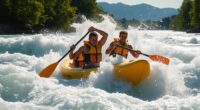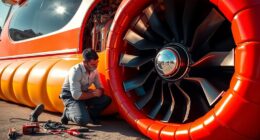When solo canoeing, focus on using your core muscles for effective paddle strokes. Plant your paddle deep for strong forward strokes and pivot for steering. Always wear a PFD for safety, and bring essential gear like a whistle and first aid kit. Stay aware of your surroundings and changing weather conditions to enhance your experience on the water. Balancing technique with safety not only boosts your confidence but also deepens your connection with nature—discover additional tips to elevate your journey.
Key Takeaways
- Focus on using your core muscles for powerful, efficient paddle strokes instead of relying solely on your arms.
- Master forward and ruddering strokes to enhance propulsion and steering control while navigating.
- Stay aware of your surroundings and weather conditions to ensure safety and enjoyment during solo outings.
- Consistent practice of techniques helps develop rhythm and confidence in your paddling skills.
- Embrace the tranquility of solo canoeing to connect with nature and enhance your overall experience.

Have you ever felt the thrill of gliding across a serene lake, the only sounds being the gentle splash of your paddle and the call of distant birds? Solo canoeing offers that unique blend of tranquility and adventure, allowing you to immerse yourself in nature while honing your skills as a paddler. To make the most of your solo experience, it’s *vital* to master the techniques that will enhance your journey and keep you safe on the water.
When you’re out there alone, efficient paddle strokes become your best friend. Each stroke should be deliberate, using your core muscles rather than just your arms. Start with a strong forward stroke, planting the paddle blade deep in the water and pulling back in a smooth motion. This technique not only propels you forward but also maintains your balance. Don’t forget to incorporate a ruddering stroke, where you pivot the paddle to steer, especially when you face winds or currents. It’s amazing how a slight adjustment can keep your canoe on track, helping you navigate with ease.
Safety gear is just as important as technique. Before you even set foot in your canoe, make sure you’ve got the right equipment. A personal flotation device (PFD) should be your first priority; it’s essential for your safety. Even if you’re a strong swimmer, unexpected situations can arise, and wearing a PFD gives you peace of mind. Additionally, consider bringing a whistle and a basic first aid kit. These small items can make a significant difference in emergencies, and being prepared is part of the solo experience. Remember, just like with an airless paint sprayer, proper maintenance of your gear ensures optimal performance and safety.
As you paddle, keep an eye on your surroundings. The beauty of solo canoeing is the chance to connect with nature, but it also means you must stay aware of changing weather conditions. If dark clouds roll in or the wind picks up, be ready to head back to shore. Trust your instincts; they’re your best guide when you’re out alone.
Lastly, don’t forget to enjoy the moment. Solo canoeing is about finding your rhythm on the water, embracing both the solitude and the serenity. Let each paddle stroke be a reminder of your connection to nature. By combining solid techniques with essential safety gear, you’ll not only enhance your solo canoeing experience but also create lasting memories on the water. So grab your paddle, and let the adventure begin!
Frequently Asked Questions
What Is the Best Canoe for Solo Paddling?
The best canoe for solo paddling is one that offers great stability and maneuverability. Look for a canoe with a width that provides balance while you practice solo paddling techniques. A stable design, like a recreational or touring canoe, will help you feel secure on the water. Consider factors like weight and material too, as they’ll affect how easily you can handle your canoe solo. Choose wisely, and you’ll enjoy your paddling adventures!
How Do I Transport a Canoe by Myself?
To transport a canoe by yourself, you’ll need a reliable method. Use a canoe cart for easy movement over land, or if you’re lifting it, balance it on your shoulders. Secure it with straps for stability. When loading, use proper paddling techniques to avoid injury. For canoe storage, consider a rack or wall mount to keep it safe and accessible. With practice, you’ll feel confident transporting your canoe solo!
What Safety Gear Is Essential for Solo Canoeing?
For solo canoeing, essential safety gear includes a life jacket and a reliable communication device. Always wear a properly fitted life jacket to guarantee your safety on the water. A communication device, like a cellphone or a marine radio, lets you call for help if needed. Additionally, consider bringing a whistle, a first aid kit, and a map of the area. These items can greatly enhance your safety during your paddling adventure.
Can I Canoe Alone in Rough Waters?
You can canoe alone in rough waters, but you need to guarantee your canoe has good stability. It’s crucial to evaluate your paddling stamina, as steering through choppy conditions can be physically demanding. If you’re not experienced, consider practicing in calmer waters first to build your skills. Always wear a life jacket, stay aware of weather conditions, and have an exit plan. Prioritizing safety will help you enjoy your solo canoeing adventure.
How Do I Navigate Without a Partner?
Exploring alone? Who needs a partner when you’ve got the magic of solo paddle strokes! First, use your keen sense of direction—just don’t follow the ducks. Try solo canoe tips like setting landmarks and keeping a steady pace. Adjust your strokes for turns, and remember that paddling in circles is just an avant-garde way to explore! Stay calm, rely on your instincts, and you’ll be the solo adventurer you always dreamed of being!
Conclusion
In solo canoeing, you’re not just paddling; you’re embracing the freedom of the water. Did you know that nearly 70% of solo paddlers report a stronger connection to nature? Imagine gliding across a serene lake, the gentle ripples reflecting the sky, all while feeling that bond deepen with each stroke. With the right techniques, you can enhance your experience, making every journey not just a paddle but a personal adventure waiting to unfold.










